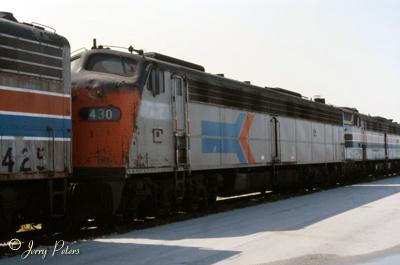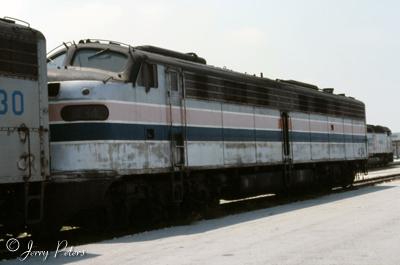 |
 |
 |
 |
Alaska Railroad's E-8's
By Jerry Peters
First, I need to tell everyone that what I am writing here is based almost totally on my memory. I did bring some files home when I retired from the Alaska Railroad, but I haven't been able to find anything about our two “E” units (2401, 2402).
Sometime in the spring of 1981 ARR upper management received word that AMTRAK was going to get rid of some of their E unit passenger locomotives. It seemed, at that time, that the ARR wanted to try to get a couple of the units as they would be almost free, as we also were a Federal Government agency.
I was sent back to the lower 48 states to look at the units that AMTRAK was releasing. I went to Washington DC first, and looked at a number of locomotives that were available, then to Miami, Florida, again to look at some other E units.
After about a week of looking around at Amtrak's excess E units, I selected one unit that was in Washington, DC, and one in Miami. What I remember is that these units were complete, not having been cannibalized, and their diesel engines seemed to be in reasonable condition. The 2401 was originally from the Union Pacific RR, their 957, and the 2402 from the Milwaukee RR, first their 202A, then 32A.
These units were acquired by the ARR, and arrangements were made to have them shipped to Seattle, Washington for loading on a barge for shipment to Whittier, AK, then to Anchorage. There was no hurry. I remember that the BN Railroad was asked to make sure that the units would be drained of cooling water and would not freeze up.
As I remember, these units arrived in Anchorage late in the fall, but at different times.
We decided to go ahead and operate one of them, 2401 I think, in Passenger service in its AMTRAK paint, with ARR stencils, and put the other, 2402, I think, in the shop for upgrading to our Railroads standards, i.e.: dynamic brakes, snow plow pilot, thirty-eight inch driving wheels and freight gear ratio, and a complete paint job.
It had been decided to install dynamic braking and change the traction motor-to-axle gear ratio to sixty-two / fifteen (gear teeth) using thirty-eight inch wheels in the powered positions, namely no. 1, no. 3. no. 4. and no. 6. No's 2 and 5 were left at 36 inch. This was because our maximum track speed was sixty MPH, and the "E's" were set up to run at over ninety MPH.
We were able to complete the electrical and mechanical conversions on the first unit, and have it painted in the "Chester Mack" scheme. As I remember, we installed a 250 KW generator set in place of the steam generator for passenger car heating.
During all this, we were able to bring the other unit into the shops for its conversions and up-grades. It was found, after it got into the shop, that both engines were still full of water, and had frozen while being shipped on the barge to Whittier. All of the exhaust elbows from the heads to the exhaust manifolds had been crushed flat in the freezing of the engines.
Our shops were not capable of repairing the engine blocks, so it was decided that we should find two replacement engines to replace these.
This is interesting. The Chief Mechanical Officer at that that time, Mike Sudol, had been working on buying some GP40's for us.
I was sent to Silvis, Illinois to first look at six old ex-Penn-Central GP40's (3016 thru 3020) that Mike had picked for us, and then go through a bunch of used 567 twelve cylinder engines to replace the frozen units. I did find two that seemed to be in the best condition of them all.
This unit, the 2402 I think, was completed with a Vapor model 4625 steam generator for passenger car heating.
Some
time around 1987-88, our management decided that the
six wheel trucks on the E-9's were causing an extreme rate of wheel flange
wear due to the many tight curves on our railroad. It
didn't take long, and they were gone, something
like six months, from what I remember.
Page created 6/5/08 and last updated 6/8/08